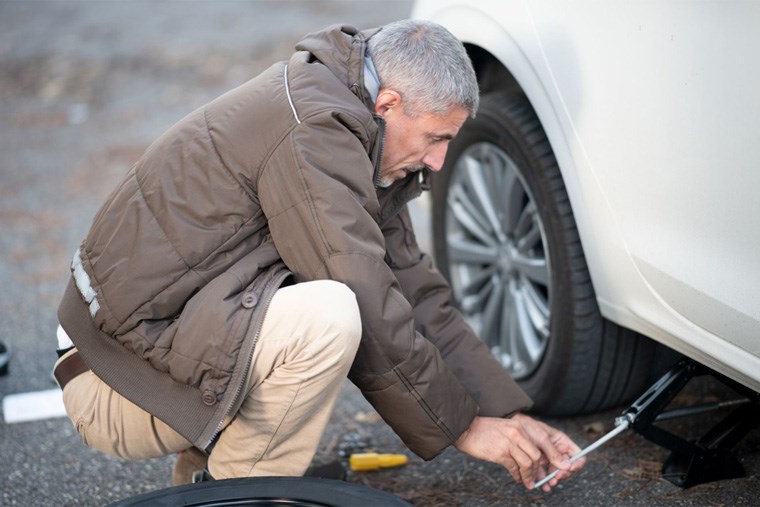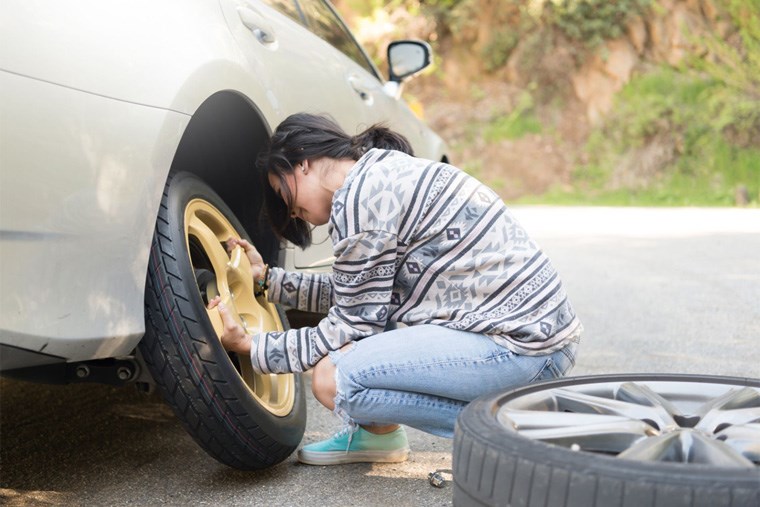Knowing how to change a car tire before one goes flat is an essential skill for anyone who drives or rides in cars. If you rely on others to change your tire, there is always the chance you won’t be able to reach anyone, or it might take hours for help to reach you.
Even if you do know how to change a tire, do you know the best practices? Many people know the basic idea but make critical mistakes when a tire goes flat. Where should you put the jack? How can you make sure the replacement wheel is secure? How far can you drive on a spare?
Fortunately, changing a tire is easy to learn and master if you follow these simple steps.
Be prepared before your tire goes flat.
We can’t anticipate when a tire will go flat, so it’s essential to take the necessary steps to prepare before that nail goes into it. Make sure you have – at a minimum – a car jack, a wrench, and a spare tire in your car at all times. Most cars will come with the wrench, but check that you have one that fits your lug nuts and, if you have a hubcap, has a flat side. In addition, keep your owner’s manual in the car at all times. The manual has important information like the intended spot for the jack and how far you can drive on your spare.
Find a safe, level place to change your tire.
If possible, drive your car out of the way of traffic and onto the side of the road, making sure to leave enough room to work. Try to find a level spot on the ground with plenty of room for you to work on the side of the flat tire. This will prevent your car from rolling while raised.
Secure your car for raising.
Before you put your jack on the ground, make sure your car is in park and the parking brake is applied. Even on level ground, your car can roll off the jack if the parking brake is not applied.
Place your jack in the right spot.
Most car manufacturers have exposed metal plates specifically to hold the weight of the car when raised on a jack. Reference your car owner’s manual for the specific spot, but it should be just behind the front tires or just in front of the back tires and inside the car’s outer shell.

Raise your car with the jack.
After the jack is positioned correctly under the metal plate by the flat tire, insert the handle and begin raising the jack. Once it nears level with the bottom of the car, check it one more time to make sure it’s in the right spot. If it’s in that sweet spot, continue pumping the jack to raise the car. Aim for about 6 inches between the bottom of the flat and the road.
Unscrew the lug nuts and take the tire off.
Many cars will also have a hubcap that hides the lug nuts. Look for a slit or tab for putting the flat end of your wrench inside to pop off the hubcap. Once that’s off, use the wrench to loosen the lug nuts. Then, take the tire off and place it out of the way of traffic, ideally directly into your trunk.
Place the replacement tire on and tighten the lug nuts until snug.
You don’t want to tighten the tire all the way while the tire is still in the air. Tighten them until you get some resistance, making sure that the wheel is resting on the shoulder of the bolt instead of the threading. Wait until the tire is on the ground to tighten further.
Lower the jack and fully tighten the wheel.
Make sure to tighten the nuts to the specs outlined in your owner’s manual while the car’s weight is on the tire, and not while it’s in the air. To ensure this is the case, lower the jack until the tire touches the ground, and tighten the bolts further, following a star pattern around the wheel. After that, lower the jack the rest of the way and tighten to specs, again following the star pattern.
Make sure your replacement tire is safe to drive on.
After the tire is on the ground, check tire pressure to ensure your replacement is safe and set to the proper reading outlined in your owner’s manual.
Changing a flat tire doesn’t have to be a significant ordeal. With this step-by-step guide, you’ll be able to quickly swap it out and be on your way in no time!
 This story was made possible by our Community Partners Program. Thank you Cam Clark Ford Canmore for helping to expand local news coverage in Alberta. Learn more.
This story was made possible by our Community Partners Program. Thank you Cam Clark Ford Canmore for helping to expand local news coverage in Alberta. Learn more.



